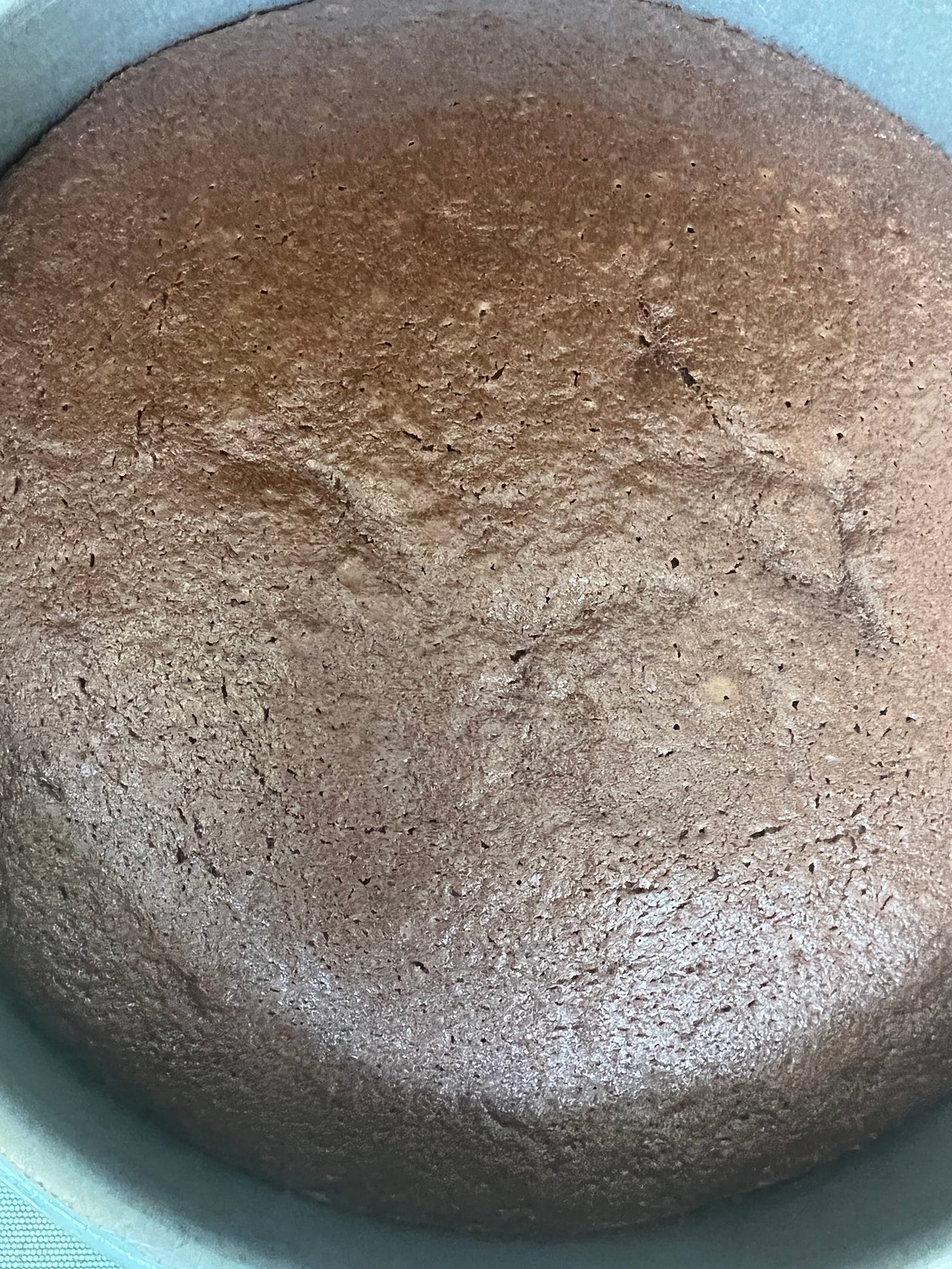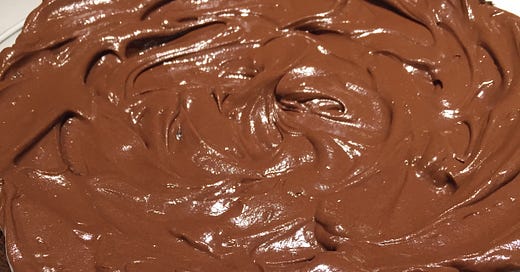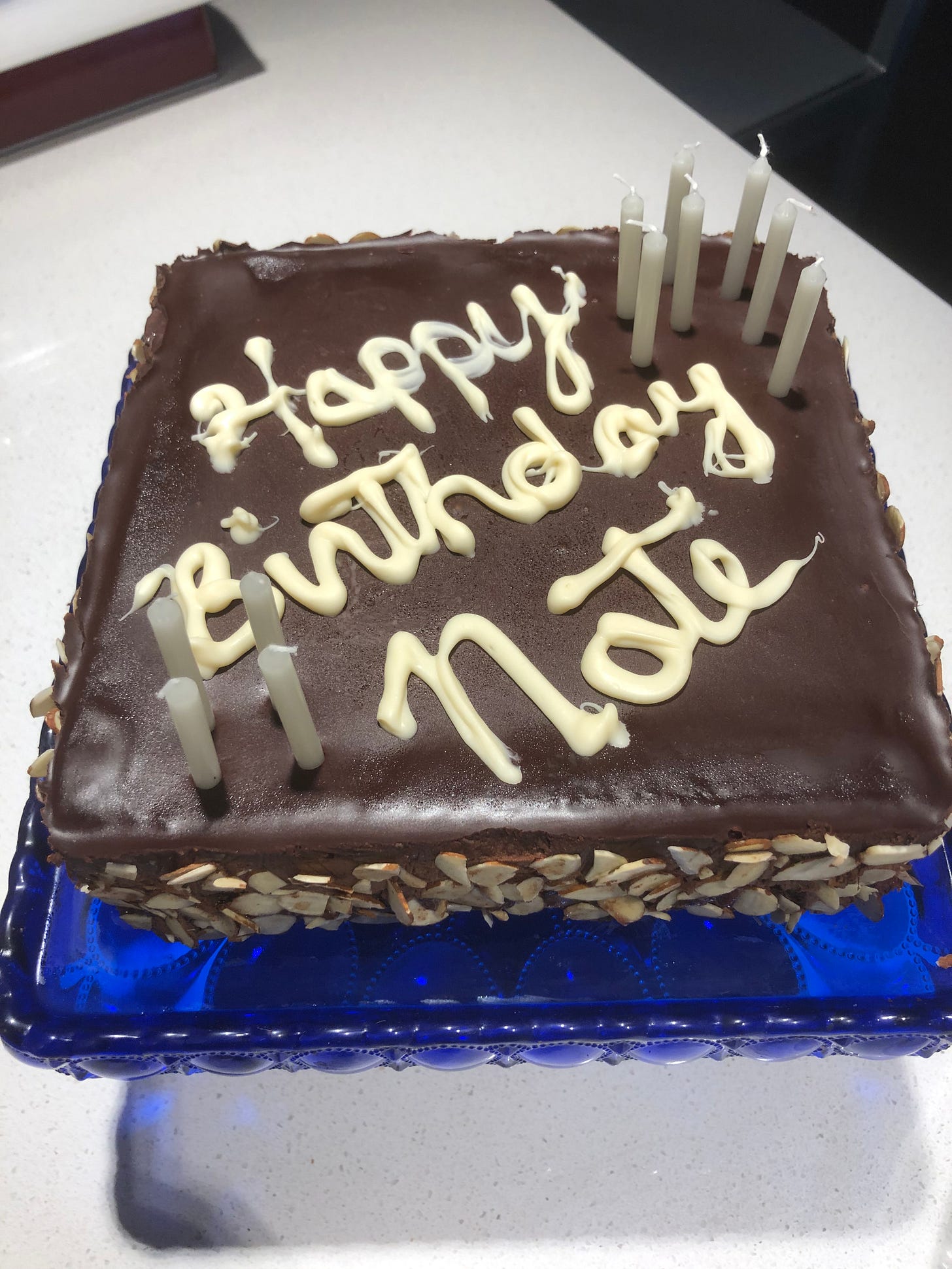A Perennial Favorite, Birthday or Not: Aunt Josephine’s Chocolate Cake
Family Recipes, Aunts who Bake, Snacking versus Celebration Cakes
I’m celebrating Issue #40 by baking a cake, a chocolate cake, using an old family recipe. (Actually, it’s for Nate’s upcoming birthday, but you’ll read more about that below.) Given all that’s going on in the world, I think a little sweetness is called for. Serves 1 to 10. Hope you enjoy it. Thank you for subscribing. —Mitchell
Chocolate cake is in a category by itself. I say this as a vanilla/lemon lover, meaning that I would almost always prefer a vanilla or lemon dessert to something chocolate. But even if you aren’t a chocolaholic, one bite of a good chocolate cake is pretty hard to disagree with.
I am in a mixed marriage, by which I mean, Nate, my husband, is a chocolate lover. He thinks I may know something about food, but I don’t know anything about dessert because I’d almost always pick the one that isn’t chocolate.

Nate’s birthday is coming up, so I’m baking a chocolate cake, of course. When considering which of the myriad chocolate cake recipes in my repertoire I would select, I decided to go with a family favorite, Aunt Josephine’s Chocolate Cake, a cake I grew up on.
My mother was an excellent cook and she loved to bake, especially when it rained. Just about everything she made was delicious, but she had a limited repertoire—one method for roasting chicken, one style of macaroni and cheese (The Cheese Thing with canned tomatoes and two types of cheddar), one way to cook flounder (breaded in matzo meal and fried in butter), one Italian spaghetti sauce (with sausages and meatballs). The same was true when it came to baking. She relied on a collection of reliable, repeatable recipes that we loved—Russian sour-cream coffee cake, lokshen kugel with cherry topping, Aunt May’s cream cheese cookies, and Aunt Josephine’s chocolate cake.
In fact, many of my mother’s recipes originated with our Aunt Josephine, who we would learn when we were older wasn’t our real aunt at all, but my mother’s neighbor and best friend from the time they were both three. (In contrast, Aunt May was my grandmother’s sister, who was famous for her cream cheese cookies and profiteroles.) Aunt Josephine’s family was originally from Sicily, and all the Italian dishes in my mother’s repertoire, such as that spaghetti sauce, long simmered and studded with chunks of sausage and meatballs, chicken parmesan, lasagna, were ostensibly learned from their family. So were many cakes in my mother’s rotation—which weren’t really Italian at all, come to think of it —including the Russian sour-cream cake (a rich pound cake with layers of streusel) and this sour-cream chocolate cake. (I’ve only just now realized both of these cakes feature sour cream, so maybe that was a common thread. Hmn.)
Anyway, I just visited with my Aunt Josephine a few weeks ago, now 87 years old and still living in the house she grew up in in Ridgefield, New Jersey, one house away from where my mother grew up. Perhaps that visit is why her cake was on my mind for Nate’s upcoming birthday.
I’ve been making this cake since I was 10 years old and before that I watched my mother make this cake often. I know the recipe by heart. Twenty-five years ago, when my first cookbook Cook Something came out, I was promoting it on Arthur Schwartz’s popular Food Talk radio show on WOR. I was doing the show with my sister, Carrie, who also had a new cookbook out, The Naturally Sweet Baker. We were kibitzing about this and that, as you did with Arthur, and we started to talk about our Aunt Josephine and her chocolate cake. Arthur used to take calls from listeners, and all of a sudden we heard a familiar voice. “Hello! It’s me! This is Aunt Josephine.” Unbeknownst to us, she was an avid listener of the show and she had been driving someplace during the noon hour when she heard us talking about her cake. She pulled over the car to call in from a pay phone. (This was before everyone had a cell phone.)
A Word About Simple Cakes
As we are relearning with the advent of the snacking cake trend, cakes do not have to be fussy or difficult to be enjoyable. Maybe we have watched too many baking competitions on T.V.—I’m as guilty as anyone—that have led us to believe that every cake should be multilayered, multitiered and shaped like something cake is not. A simple cake is wonderful and often all you need.
This is a simple chocolate cake. It is mixed in one bowl, without an electric mixer, and because the butter is melted with the chocolate it doesn’t need to be creamed. It is a forgiving cake, meaning you can use sour cream, as intended, but if you don’t have it, full-fat yogurt will work, or even buttermilk or soured milk maybe enriched with a little heavy cream. The original recipe calls for water, but sometimes I add coffee. You can add some liqueur, such Grand Mariner, or maybe Bourbon.
As I’ve insisted for years, despite common wisdom, baking is much more forgiving than we’ve been led to believe. Sure, if you have a bakery and you are supposed to make the exact same thing every time, you need to follow a recipe strictly. But if you are just making a quick cake to snack on and you don’t have enough unsweetened chocolate, you can add some 85% in and no one will know. You can substitute some of the white flour for rye, switch up the water for cold Earl Grey tea.
I want to say something about the way this cake looks. We’ve become used to devil’s food cake, which is usually made with cocoa, which turns black when it comes into contact with baking soda. This cake calls for unsweetened chocolate, melted. It is not as dark as a cocoa cake, but it is every bit as chocolatey, maybe more.
Nate may think I don’t know anything about chocolate cake, but I know this (and I’ve taught it to him): all chocolate cakes are better after they sit a day. This curing develops the flavor more so that they are more chocolatey. It seems counter intuitive, that a freshly baked cake ought to be best. But as we are learning about certain fish, a little aging can encourage more flavor to develop. Trust me. Bake this and any chocolate cake a day in advance, cool it, wrap it, and let it sit at room temperature (refrigerate if you are going to frost it) and you will have a better-tasting cake.
About the chocolate. My mother only ever used Baker’s unsweetened chocolate from the grocery store. Nothing fancy. Sure, you can use 100% Valrhona chocolate. I usually have large chunks of unsweetened Callebaut at home. But expensive, imported chocolate isn’t necessary to make a delicious cake. And if you don’t have unsweetened chocolate, use what you’ve got, preferably 85%, which doesn’t add too much sugar and still has a strong chocolate taste. If you have to use anything lower, say 65 or 70% chocolate, add a couple of tablespoons of cocoa powder and decrease the sugar by a couple of tablespoons, as well. (The cocoa will make the color of the cake darker, as noted above.)
When Is It Done?!
One of the most common problems with cake is that people overbake it. Nobody likes a dry cake. Well, that’s not exactly true. From my Jewish heritage I have an appreciation for crumbly baked things you have to choke down with coffee. But a chocolate birthday cake should be moist. Chocolate cake has the added disadvantage of being dark, so you can’t use the visual cue of browning to help determine doneness. To judge when this cake is done, I look for a domed top that doesn’t wobble and shows hairline cracks on the surface. It should have pulled away from the sides of the pan and should be a little springy to the touch of your fingertips. It should also smell done, which is something chocolate cake does. (It also has a distinct smell when overdone.) If you aren’t sure, stick an instant-read thermometer in it. At about 195°F, everything in your cake (eggs, starch, etc.) will be cooked. Pass 200°F and it’s on its way to overdone. Always set the timer five minutes sooner than you are told to account for the variability of heat between ovens and then increase it in one- or two-minute increments until you think it is ready. And remember, like a steak, the cake will continue to “bake” for a minute or two more outside the oven. If worse comes to worse and the cake is overbaked, consider dampening it with a sugar syrup flavored with rum or bourbon or liqueur or more coffee or something you like.

Finally, you can ice and decorate this cake however you like, but in the snacking cake tradition, we only really ever had it dusted with powdered sugar, or on birthdays, covered with whipped cream, which is all the cake needs to be thoroughly satisfying—that, and a tall glass of milk.
RECIPE: Aunt Josephine’s Chocolate Cake
Makes two 8- or 9-inch round layers, one 9’ x 13”-inch rectangular cake, two 8 ½-inch loaves, or 18 cupcakes, serving 1 to 10 or more
112 g (4 oz) unsweetened (100%) chocolate
112 g (4 oz) unsalted butter
1 cup water, coffee, milk, or a combination
1 cup sour cream, Greek yogurt, or a combination of soured dairy products
1 teaspoon baking soda
2 cups sugar
2 eggs
1 teaspoon vanilla
Pinch of salt
2 cups all-purpose flour
1 teaspoon baking powder
Preheat the oven to 350°F. Grease your pans. If making layers or loaves, I like to line the bottom with parchment to ensure easy removal. Cupcakes are well served by paper cups. A rectangular cake I usually just eat out of the pan, so no need for parchment.
In a small saucepan, combine the chocolate, butter, and water and set over low heat to melt. Keep an eye on it and stir frequently to prevent scorching. Once melted, cool to room temperature. Meanwhile, in a medium bowl, combine the sour cream and baking soda. This will bubble up and expand, which is what you want.
In a large bowl, whisk together the sugar and eggs until combined. Beat in the vanilla and a pinch of salt. Stir in about half the cooled chocolate mixture. Add 1 cup of flour and the baking powder and mix. Add the sour cream mixture, the remaining chocolate, and the remaining cup of flour and continue mixing just until combined. Don’t overmix. The batter will be quite loose.
Divide the batter evenly among the prepared pans. Place in the preheated oven and set a timer for 25 minutes. It will take longer, especially if you are making loaves, but this is a good time to start checking. A rectangular cake or the 8-inch layers usually take a total of 35 minutes. Loaves will take longer.
When done (see above for signs), remove from the oven and let cool on wire racks for about 15 minutes. Run a knife around the edge of the pan and invert on the racks. Remove the parchment, if using, and cool completely. Wrap in plastic and let sit for a day if you can. Chill if going to frost it. Serve with powdered sugar, whipped cream, or any frosting you wish.








❤️ Hmn. Milk chocolate could work but you’ll need quite a bit more cocoa for flavor. Maybe 1/4 cup.
Aunt Josephine stopping her car to call you from a pay phone after hearing you on the radio..priceless. Question: Can I use milk chocolate and add the cocoa and take out some sugar as you suggest? And did you frost it with buttercream?